| |
|
|
 |
Therapy
 Reconstructive Therapy
Reconstructive Therapy  Dental
Implant Therapy
Dental
Implant Therapy |
 |
| |
| DENTAL IMPLANT THERAPY: WHY IT IS THE STANDARD OF CARE
|
|
Implant treatment is recognized as the treatment of choice in replacing lost teeth. Because older methods of tooth replacement, such as bridges, partials, and dentures, have disadvantages in terms of both appearance and function, dental implants are better. Replacement teeth supported by dental implants have success rates higher than 90 percent in long-term function.
A dental implant is a small screw made of titanium, which is a metal that the body easily accepts. The dental implant is inserted into the jawbone and acts as a firm anchor for the replacement tooth.
 How
do I know if dental implants are right for me?
How
do I know if dental implants are right for me?
Your dentist will determine whether dental implants are right for you after an evaluation of your dental and medical history. Naturally, every patient presents unique conditions that can affect the outcome of a dental implant treatment, but taking proper care of the implants will help to ensure long-term success.
Thanks to recent advancements in implant techniques, many people with missing teeth qualify as candidates for implant treatment. Some of the determining factors include:
• A sufficient amount of good quality bone
• Good oral hygiene
• Good general health
• Regular check-ups with your dentist
Each situation has a slightly different process, but generally, we place the implant in the jaw using a gentle surgical procedure. Many patients claim that having a dental implant placed is less traumatic than having a natural tooth extracted. After the bone has bonded with the implant, the next step is to create a crown. In a few appointments, your dentist will attach a post (abutment) to the implant, take impressions of your teeth, and check for proper fit and color of the crown.
 Replacing a Single Missing Tooth
Replacing a Single Missing Tooth
When a single tooth is missing, the two most common treatment options are the older tooth-supported bridge and an implant-supported crown.
When a traditional bridge is used to replace a missing tooth, the adjacent teeth are cut down to pegs in order to fit the cemented bridge in place. You end up needing multiple crowns to replace the destroyed teeth. This method of tooth replacement can be very esthetic and functional for a period of time. However, a tooth-supported bridge does not replace the bone that previously surrounded the root. Since there is no longer a root to hold the bone in place, the bone deteriorates, or melts away.
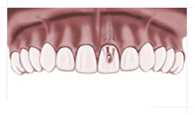
• A dental implant looks, feels and functions like a natural tooth
• It provides an esthetic, long-term solution to a missing tooth
• It does not decay
• There is no need to grind down the adjacent natural teeth
• The bone is preserved, preventing a visible bony defect
• It is more hygienic (easier to clean) than a tooth supported bridge
 Replacing Multiple Missing Teeth
Replacing Multiple Missing Teeth
When more than one tooth is missing, there are three common treatment options: a tooth-supported bridge, a removable partial denture, and an implant-supported bridge. In this situation the benefits of implant supported teeth are even more obvious.
A removable prosthesis, such as a partial denture, actually accelerates the bone resorbtion process, resulting in more rapid bone deterioration. In addition, the clasps which hold the partial denture in place put extreme pressure on the natural teeth they hook onto, loosening them and in many cases, eventually leading to the loss of those teeth. Most patients with partial dentures state that they are uncomfortable and that they rarely wear them.
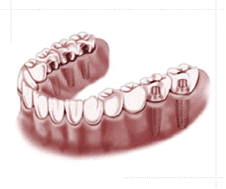
• Dental implants look, feel, and function like natural teeth
• They are much more comfortable and stable than partial dentures
• Natural biting and chewing capacity is restored
• They virtually stop the bone resorbtion process (deterioration)
• The integrity of the facial structures is maintained
• Adjacent natural teeth are not compromised (ground down to pegs or loosened)
 Replacing all teeth with Dental Implants
Replacing all teeth with Dental Implants
In the past, people missing all of their teeth had no option but dentures. This prosthesis has numerous disadvantages, such as:
• Dentures are uncomfortable and often painful
• Dentures do not look or feel natural, especially when eating
• As the bone continues to melt away, the dentures become loose and can fall out when laughing, sneezing, or coughing
• People without their teeth and supporting bone visibly age much faster
• Wearing dentures usually undermines a person's self-confidence (they have missing body parts and do not feel complete or natural)
• People with dentures may have difficulty eating foods such as steak, corn on the cob and apples
• People with dentures are prone to bad breath
 Step by step process
Step by step process
Each situation has a slightly different process, but generally, we place a dental implant in the jaw using a gentle surgical procedure. (Many patients claim that having a dental implant inserted is less traumatic than having a natural tooth extracted.) After the bone has bonded with the implant, the next step is to create a crown. Your dentist takes care of that. In a few appointments, your dentist will attach a post (abutment) to the implant, take impressions of your teeth, and check for proper fit and color of the crown.
Here is a step-by-step process of how a missing tooth
can be replaced using a dental implant:
|
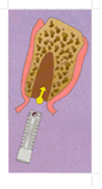 | |
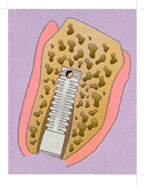 | |
1. Place the Implant - With gum tissue
opened to expose the area of bone, we
use a special drill. Once the bone has been
prepared, we can place the implant. | |
2. Healing Phase - Sutures are removed within 7
to 10 days. During the healing phase the bone
begins to grow onto the newly placed implant. This
process is called osseointegration. | |
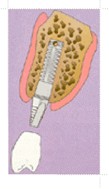 | |
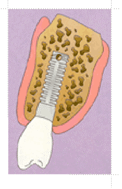 | |
3. Attach the Post – We remove the
cover screw and attach a special post (abutment) to the implant, which will
support the new crown. | |
4. Deliver the Crown – We take impressions and
place a temporary crown. After it’s constructed, the
final crown fits over the abutment. | |
|
|
